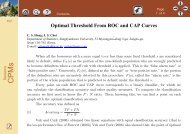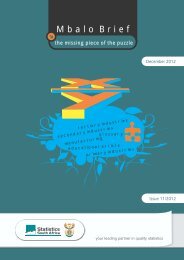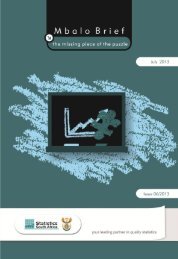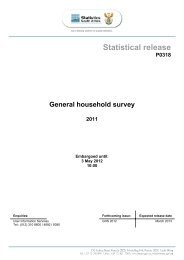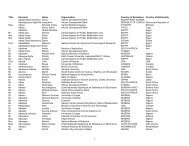Post-enumeration Survey (PES) - Statistics South Africa
Post-enumeration Survey (PES) - Statistics South Africa
Post-enumeration Survey (PES) - Statistics South Africa
Create successful ePaper yourself
Turn your PDF publications into a flip-book with our unique Google optimized e-Paper software.
<strong>Statistics</strong> <strong>South</strong> <strong>Africa</strong><br />
7<br />
2.3.1 Sampling process<br />
The ultimate purpose of the <strong>PES</strong> was to evaluate the quality of the census data by providing quantitative<br />
information on coverage and content errors. The evaluation focused on the nine (9) provinces in <strong>South</strong><br />
<strong>Africa</strong>, namely Western Cape (WC), Eastern Cape (EC), Northern Cape (NC), Free State (FS), KwaZulu-<br />
Natal (KZN), North West (NW), Gauteng (GP), Mpumalanga (MP) and Limpopo (LP). The initial sampling<br />
frame for the <strong>PES</strong> was the complete list of Census 2011 <strong>enumeration</strong> areas (EAs), amounting to<br />
103 576 EAs. However, this frame was reduced to 89 305 EAs after the exclusion of out-of-scope EAs<br />
which amounted to 14 271 EAs (13,8% of all the Census 2011 EAs). It was desired to have included the<br />
workers' hostels in the <strong>PES</strong> sample, but the current EA type classifications did not single out workers'<br />
hostels. Instead, all institutions, including workers' hostels, etc., were put together to form a type called<br />
'Collective Living Quarters'. Vacant EAs, parks and recreation, industrial, commercial and collective living<br />
quarters were excluded from the <strong>PES</strong> 2011 frame. The out-of-scope EA types are excluded due to the<br />
difficulty in tracking movers for matching purposes.<br />
The stratification and sampling process was designed to allow for the provision of estimates at national,<br />
provincial, urban and non-urban levels, but estimates will only be reliable at national and provincial<br />
levels.<br />
2.3.2 Stratification<br />
To improve the efficiency of the <strong>PES</strong> sample design, the sampling frame was divided into homogeneous<br />
strata. For this purpose, variables correlated with coverage error, such as geographic area, were<br />
chosen, since density and accessibility affect the quality of census coverage. In addition, geographic<br />
stratification is necessary to obtain separate estimates by domain of analysis. Therefore, the first level of<br />
stratification corresponded with the geographic domains of estimation defined; namely province and<br />
urban/non-urban zones of residence.<br />
For post-stratification, variables correlated with the extent of coverage, such as subdivisions that were<br />
well delimited and possessed a high degree of internal homogeneity with regard to socio-demographic<br />
characteristics were used. Hence, the sampling frame of EAs was implicitly stratified by geography type:<br />
urban formal, urban informal, tribal area, and rural formal.<br />
2.3.3 Sample size and allocation<br />
A sample of 600 EAs was selected from the total of 89 305 EAs from the Census 2011 EA frame and<br />
was allocated to the provinces based on the <strong>PES</strong> 2001 standard errors (SEs). The provincial samples<br />
were further allocated to strata using proportional allocation. International best practices recommend a<br />
sample size of 1% of the census EAs should be used for the <strong>PES</strong> in order to achieve acceptable<br />
precision levels. The budget allocated to the Census 2011 <strong>PES</strong> could only accommodate a maximum<br />
sample size of 600 EAs. The maximum SE level of 0,025 for the undercount rate was used in order to<br />
obtain a sample size of 600 EAs. This allowed for a reasonable 95% confidence level for the estimate of<br />
<strong>Post</strong> Enumeration <strong>Survey</strong> (<strong>PES</strong>)



